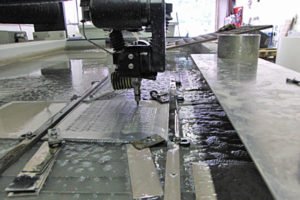Waterjet cutting is used by metal processing specialists to form highly accurate cuts for custom metal components. It is a cold-cutting technique that leverages water (or a mix of water and abrasives, such as garnet) to cut through materials via rapid erosion.
This process is suitable for cutting a variety of materials—ranging from soft products like foam and carpet to hard metals like ceramic and metal—and can cut through materials up to 8 inches thick .
Unlike laser cutters or plasma cutters, waterjet cutting tools do not rely on thermal mechanisms; instead, they eject water at three times the speed of sound. The pressurized water stream magnifies the effect of erosion to quickly and cleanly produce the necessary cuts on the material.
In support of our metal sourcing, distribution, and fabrication services, AAA Metals Company is proud to offer precision water jet cutting services with bevel cutting capabilities. Custom shapes are cut from stainless steel, nickel alloy, titanium, aluminum, copper and brass, in sheet and plate raw forms.
For more information about our advanced water jet cutting processes or the other responsive and dependable metals manufacturing services we provide please see the table below or contact us directly.
Benefits of Waterjet Cutting
Compared to other cutting methods, waterjet cutting offers numerous benefits, including:
- No heat affected zone: As mentioned previously, waterjet cutting is a cold-cutting technique that does not require material to be heated or stressed with machinery. This lack of thermal input means that there is little to no heat affected zone (HAZ) — which decreases the risk of thermal distortion, such as warping or impurities in certain materials.
- Versatility: Waterjet cutting can be used on a wide range of materials, including glass, paper, metal, foods, composites, mixed materials, and more.
- Tight tolerance: Waterjet cutting can cut parts with better tolerances, especially on thicker materials.
- Reduced slag: Since waterjet cutting leverages water and recyclable abrasives, you do not have to deal with slag byproducts that can be produced by other cutting methods, such as laser or plasma cutting.
- Ultra-fine finish: Waterjet cutting produces a fine sand-blasted edge finish, which can sometimes eliminate the need for finishing services.
Materials & Capabilities
AAA Metals offers waterjet cutting services to form custom shapes from a variety of materials, including:
- Steels (including carbon, hardened tool, stainless steel, etc.)
- Nickel Alloy
- Titanium
- Aluminum (including aluminum alloys and superalloys)
- Copper
- Brass
Our advanced waterjet equipment produces a stream capable of cutting thicknesses up to 6” for both metal sheets and metal plates.
The 5-axis waterjet cutting machine allows us to produce cuts on materials in virtually any orientation and at any angle (ranging from 0 to 90 degrees). This capability enables consistent and reliable production of complex and intricate parts, including those requiring beveling and contouring.
Industrial Applications
Waterjet cutting and multi-axis waterjet cutting operations are used throughout industry for a variety of cutting applications. Some of the industries in which they are commonly used include:
- Aerospace (aircraft engines, turbine blades, control panels, etc.)
- Architectural (marble, tile, stone, ornamental components, etc.)
- Biotech (pipes, tubes, disks, etc.)
- Chemical (tanks, pipes, tubes, etc.)
- Food processing (foam, food cutting, packaging, etc.)
- Marine (pipes, pumps, etc.)
- Mechanical (pumps, disks, rings, etc.)
- Packaging (inserts, foam, etc.)
- Pharmaceutical (tubing, disks, etc.)
- Vacuum (tubing, pumps, pipes, etc.)
- Welding (pumps, disks, rings, etc.)
Waterjet vs. Laser Cutting
In addition to waterjet cutting, AAA Metals offers another popular metal fabricating technique: laser cutting. While both of these techniques are highly versatile and suitable for a wide range of applications, there are some key differences to be aware of when choosing between laser cutting and waterjet cutting:
- Material range: Laser cutting is better suited for materials that are not highly reflective, while waterjet cutting can be used on almost any material.
- Material width: Laser cutting is best suited for thinner materials, while waterjet cutting can handle materials up to 8 inches in thickness.
- Precision: Laser cutting can produce higher precision cuts than waterjet cutting. Laser cutting has a processing tolerance in the +/- 0.001–0.003 inch range (depending upon the job), while waterjet cutting typically ranges from +/- 0.003–0.008 inch.
- Waste and noise production: Waterjet cutting is noisier and creates more waste byproduct than laser cutting.
- Thermal distortion: Waterjet cutting does not produce heat damage on materials, while laser cutting can cause some heat damage. Typically, these heat marks can be cleaned and removed post-cut.
- Engraving capabilities: Laser cutting can handle detailed engraving projects while waterjet cutting cannot.
- 3D: With multi-axis cutting equipment, waterjet cutting tools can cut in 3D while laser cutting is typically restricted to 2D cuts.
Custom Metal Fabrication with Waterjet Cutting at AAA Metal
While waterjet cutting may be the best method for your component, AAA Metals recognizes that your project’s needs are specific. That’s why our team is happy to review your project’s design and determine the best method — whether it’s waterjet cutting or laser cutting, or another metal forming service that we offer.
We offer a variety of testing and inspection procedures (e.g., surface and dimensional, ultrasonic testing, visual inspection, etc.) to ensure the quality and integrity of your metal component. We also offer value-added services, such as bending, boring, centerless grinding, double disc, grinding, drilling, forming, heat treating, rolling, stamping, and trepanning, to help you produce a fully finished part.
To find out how our waterjet cutting or laser cutting services can help with your next project, contact us today, or request a quote online.






